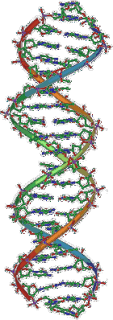Gregor Johann Mendel(20 July 1822 [ 1 ]– 6 January 1884) was a
German-speaking Silesian [ 2 ] [ 3 ]scientist and Augustinian friarwho
gained posthumous fame as the founder of the modern scienceof
genetics. Though farmers had known for centuries that crossbreeding of
animals and plants could favor certain desirable traits, Mendel's
peaplant experiments conducted between 1856 and 1863 established many
of the rules of heredity, now referred to as the laws of Mendelian
inheritance.
Mendel worked with seven characteristics of pea plants: plant height,
pod shape and color, seed shape and color, and flower position and
color. With seed color, he showed that when a yellow pea and a green
pea were bred together their offspring plant was always yellow.
However, in the next generation of plants, the green peas reappeared
at a ratio of 1:3. To explain this phenomenon, Mendel coined the terms
" recessive" and " dominant" in reference to certain traits. (In the
preceding example, green peas are recessive and yellow peas are
dominant.) He published his work in 1866, demonstrating the actions of
invisible "factors"—now called genes—in providing for visible traits
in predictable ways.
The profound significance of Mendel's work was not recognized until
the turn of the 20th century (more than three decades later) with the
independent rediscovery of these laws. [ 4 ] Erich von Tschermak, Hugo
de Vries, Carl Correns, and William Jasper Spillmanindependently
verified several of Mendel's experimental findings, ushering in the
modern age of genetics.
The Gene
The modern working definition of a gene is a portion (or sequence) of
DNA that codes for a known cellular function or process (i.e. the
function "make melanin molecules"). A single 'gene' is most similar to
a single 'word' in the English language. The nucleotides (molecules)
that make up genes can be seen as 'letters' in the English language. A
single gene may have a small number of nucleotides or a large number
of nucleotides, in the same way that a word may be small or large
(e.g. 'cell' vs. 'electrophysiology'). A single gene often interacts
with neighboring genes to produce a cellular function and can even be
ineffectual without those neighboring genes. This can be seen in the
same way that a 'word' may have meaning only in the context of a
'sentence.' A series of nucleotides can be put together without
forming a gene ( non coding regions of DNA), like a string of letters
can be put together without forming a word (e.g. udkslk). Nonetheless,
all words have letters, like all genes must have nucleotides.
A quick heuristic that is often used (but not always true) is "one
gene, one protein" meaning a singular gene codes for a singular
protein type in a cell (enzyme, transcription factor, etc.)
The sequence of nucleotides in a gene is read and translatedby a cell
to produce a chain of amino acidswhich in turn folds into a protein.
The order of amino acids in a protein corresponds to the order of
nucleotides in the gene. This relationship between nucleotide sequence
and amino acid sequence is known as the genetic code. The amino acids
in a protein determine how it folds into its unique three-dimensional
shape, a structure that is ultimately responsible for the protein's
function. Proteins carry out many of the functions needed for cells to
live. A change to the DNA in a gene can change a protein's amino acid
sequence, thereby changing its shape and function and rendering the
protein ineffective or even malignant (e.g. sickle cell anemia).
Changes to genes are called mutations.




No comments:
Post a Comment